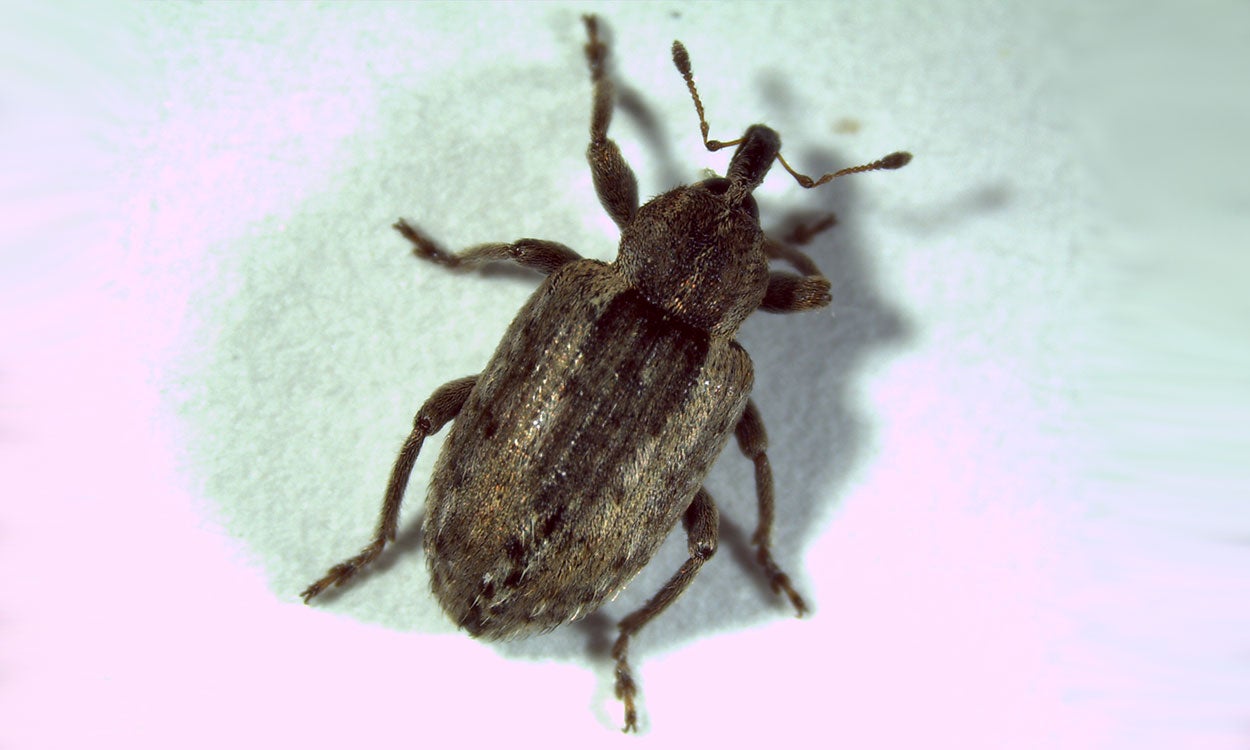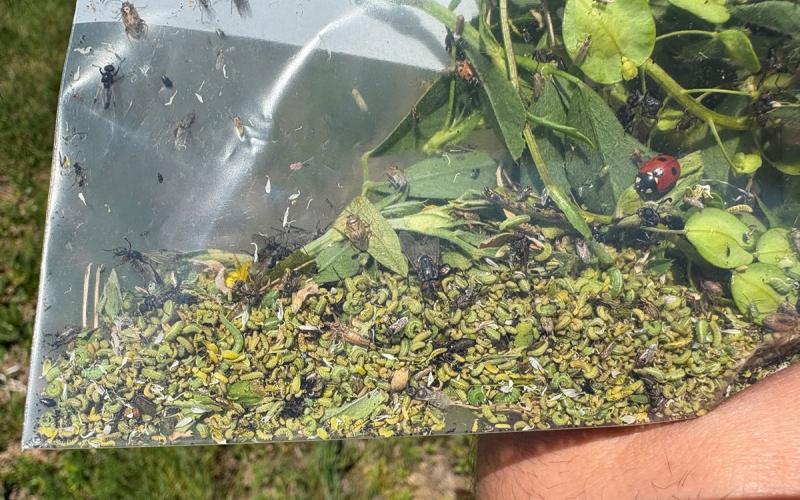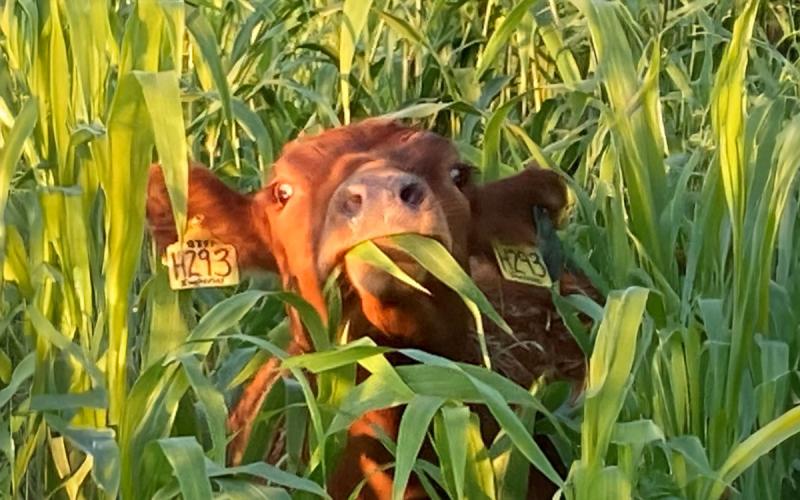Written collaboratively by Adam Varenhorst, Philip Rozeboom, Patrick Wagner, and Brad McManus.
Degree day accumulations indicate that alfalfa weevil larvae should be active throughout South Dakota. The degree day accumulation slowed down a little this last week following the cooler temperatures and precipitation, but is likely to pick back up. The last few years, the degree day accumulations haven’t lined up perfectly with alfalfa weevil activity in the state, but we will continue calculating weekly degree day increases to use as a baseline for activity.
When scouting, it’s important to remember that all instars of alfafla weevil larvae and the adults are capable of causing defoliation injury to alfalfa. Routine scouting is the best method to ensure that alfalfa isn’t heavily defiolated by this pest. In addition to larvae growth stage, the population size of the alfalfa weevils in a field determines just how much defoliation will occur, with larger infestations having a greater potential for severe defoliation. The alfalfa weevil larvae are aslo cable of causing stunting to the alfalfa plant when feeding on the terminal buds.
Identification
Larvae

Alfafla weevil larvae are small, green, and resemble caterpillars. They have an obvious white stripe on their backs and a dark brown/black head capsule (Figure 1). The larvae will have 3-pairs of legs near their head.
Adults

The alfalfa weevil adults are small, brown beetles with a darker brown stripe that runs down their midline. Alfalfa weevil adults also have an elongated snout that is characteristic of the weevil family. (Figure 2).
Scouting
The best way to determine if alfalfa weevils are present in a field is to use a sweep net and a five-gallon bucket. This method of scouting can be done quickly and provides a yes or no regarding infestation. If alfalfa weevil larvae are caputred, the next step is determine their population density. To do this, we recommend walking in a “Z” pattern and randomly sampling a total of 30 plants (for example, sample approximately 10 plants per leg of the “Z”). Each plant that is selected needs to be pulled out gently and then hit against the inside of the five-gallon bucket to dislodge any larvae that are present. We recommend this method versus trying to count the larvae on the intact plant the larvae can be hard to find.
Once completed, the plant should be measured to determine height, and the number of larvae in the bucket should be counted. Repeat this process until a total of 30 plants have been sampled. Lastly, calculate the average number of larvae and the height of the plants. Tables 1 through 4 contain threshold information for alfalfa weevils based on plant height and the number of larvae present.
Management
If thresholds are exceeded, there are several insecticides available for management. Please refer to the latest Alfalfa and Oilseeds Pest Management Guide for labeled insecticides and their associated rates. In recent years, there have been an increase in reports of pyrethroid failures when these insecticides were applied to manage alfalfa weevils in other states. If you observe a pyrethroid failure when managing alfalfa weevils please report it to Adam Varenhorst. We will also be evaluating populations of alfalfa weevils for pyrethroid susceptibility during 2025. If you have a population of alfalfa weevils that you would like tested, please contact us.
Economic Thresholds
|
|
||||
|---|---|---|---|---|
|
|
|
|
|
|
| Value of hay per ton |
|
|||
| $60 |
|
|
|
|
| $80 |
|
|
|
|
| $100 |
|
|
|
|
| $120 |
|
|
|
|
| $140 |
|
|
|
|
| $160 |
|
|
|
|
| $180 |
|
|
|
|
| $200 |
|
|
|
|
| $220 |
|
|
|
|
Source: SDSU Extension
|
|
||||
|---|---|---|---|---|
|
|
|
|
|
|
| Value of hay per ton |
|
|||
| $60 |
|
|
|
|
| $80 |
|
|
|
|
| $100 |
|
|
|
|
| $120 |
|
|
|
|
| $140 |
|
|
|
|
| $160 |
|
|
|
|
| $180 |
|
|
|
|
| $200 |
|
|
|
|
| $220 |
|
|
|
|
Source: SDSU Extension
|
|
||||
|---|---|---|---|---|
|
|
|
|
|
|
| Value of hay per ton |
|
|||
| $60 |
|
|
|
|
| $80 |
|
|
|
|
| $100 |
|
|
|
|
| $120 |
|
|
|
|
| $140 |
|
|
|
|
| $160 |
|
|
|
|
| $180 |
|
|
|
|
| $200 |
|
|
|
|
| $220 |
|
|
|
|
Source: SDSU Extension
|
|
||||
|---|---|---|---|---|
|
|
|
|
|
|
| Value of hay per ton |
|
|||
| $60 |
|
|
|
|
| $80 |
|
|
|
|
| $100 |
|
|
|
|
| $120 |
|
|
|
|
| $140 |
|
|
|
|
| $160 |
|
|
|
|
| $180 |
|
|
|
|
| $200 |
|
|
|
|
| $220 |
|
|
|
|
Source: SDSU Extension


